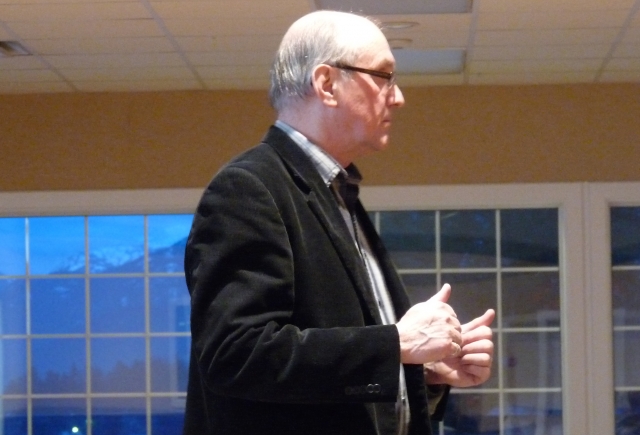Strong leadership needed for Boundary to be sustainable
Balancing self-reliance and resiliency with increasing the export economy of rural areas is the solution to creating a sustainable regional economy according to George Penford, rural innovation chair at Selkirk College. In an economy where more money comes to residents through the mail than through the mills, Penfold was clear that certain mismatches in the region must be addressed at the regional level or solutions will be hard to find. “We’re politically fragmented… but when we talk about economic development it happens regionally,” said Penfold. “In fact we live regionally. Our houses are divided municipally, but our problems are regional. That’s a challenge.” Penfold spoke to a small audience at Christina Lake on Monday night to give his take on the current economic condition of the Boundary, and provide ideas for moving forward. The Boundary is dependent economically on forestry, public sector jobs, transfer payments (social assistance, disability pensions, etc.) and non-employment income, as opposed to the job opportunities predicted in industries such as home-based businesses, e-based businesses, foods, seniors services, energy and small scale energy production. Penfold suggests that the region needs to create a clear economic development path to follow if there is any way to create future sustainability. “If what Grand Forks went through in 2007-08 happened in 1960 there would have been streets rolled up,” said Penfold. “But because there’s so much dependency on transfer payment and investment income, the impact on the service and retail economy was really buffered. As there are more seniors that will continue to happen. But markets are going to shift. There’s probably not going to be much market for skateboards in the future, more of a market for scooters.” With large projected employment growth to be in the area of services, Penfold commented that there will be a move away from resource industries. Along with market shifts will come the need to develop the labour force as well, added Penfold. He showed that majority of the current labour force in the Boundary has no secondary education, and many have not even graduated high school. “For the areas where we see opportunities for growth we’ve got a mismatch,” Penfold explained, “between people in the labour force that we have the skills those jobs require. We either get the education to develop the skills here or we’ve got to find people from outside the region to fill those jobs.” Future challenges for rural areas come from the lack of support from senior governments and the increasing costs of living. Without a shift in attitude from both the federal and provincial government, Penfold suggested the solution needs to come from local economic development planning with strong leadership to respond to changing economic conditions.
“In addition to the debt that we’re carrying we’ve got a lot of costs coming at us,” said Penfold. “The main point is that you have to frame the future in a reasonable way. Otherwise you can’t get there. Think about what kind of future that you want to create so you can marshal the resources and investments, marketing, education and training to give you the best shot at getting it.”
Penfold presented to the Christina Lake community at the request of Regional Area C Director Grace McGregor on Monday, Mar. 21.






















